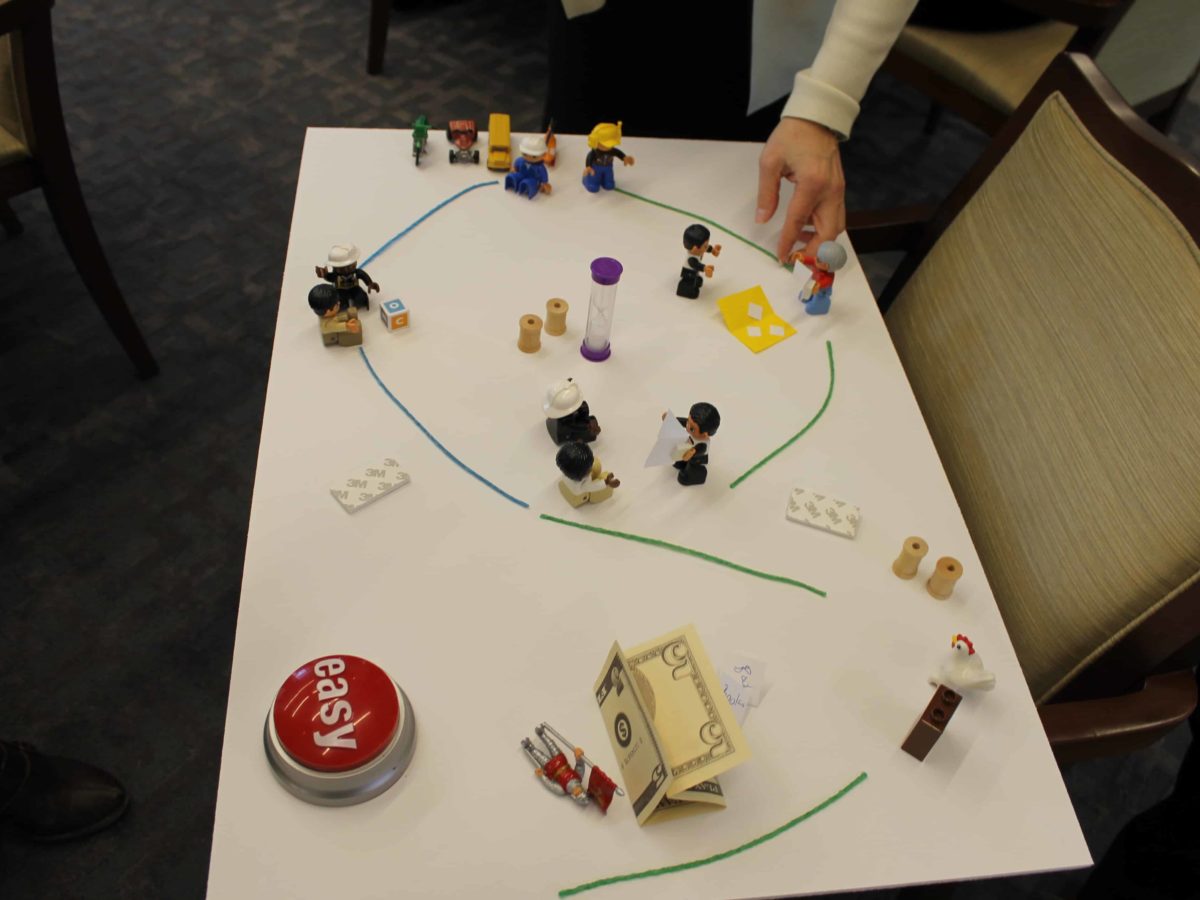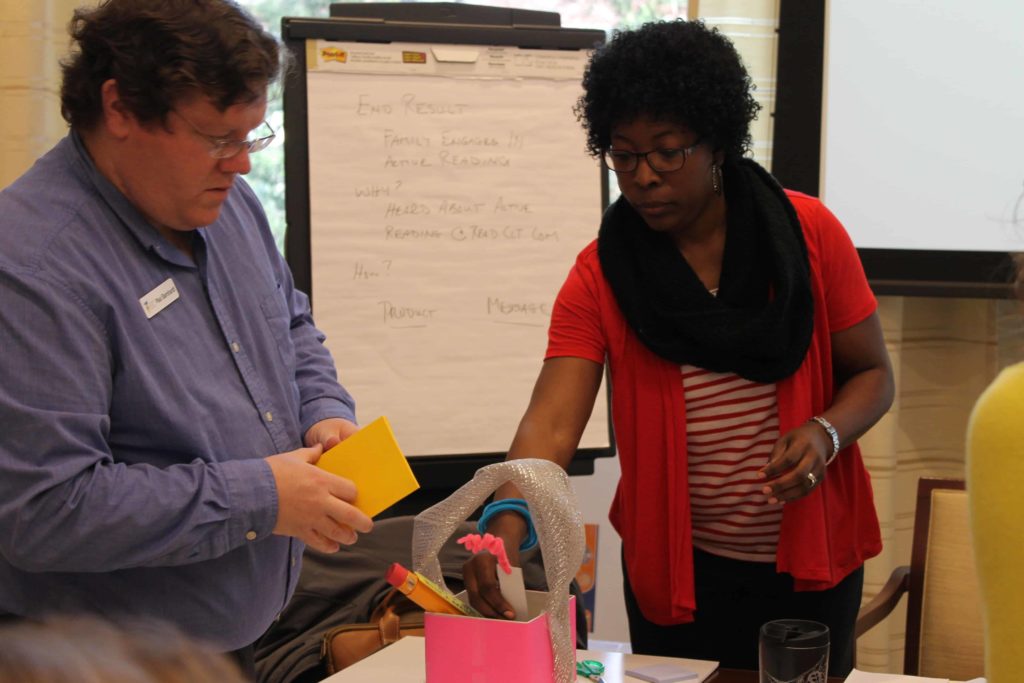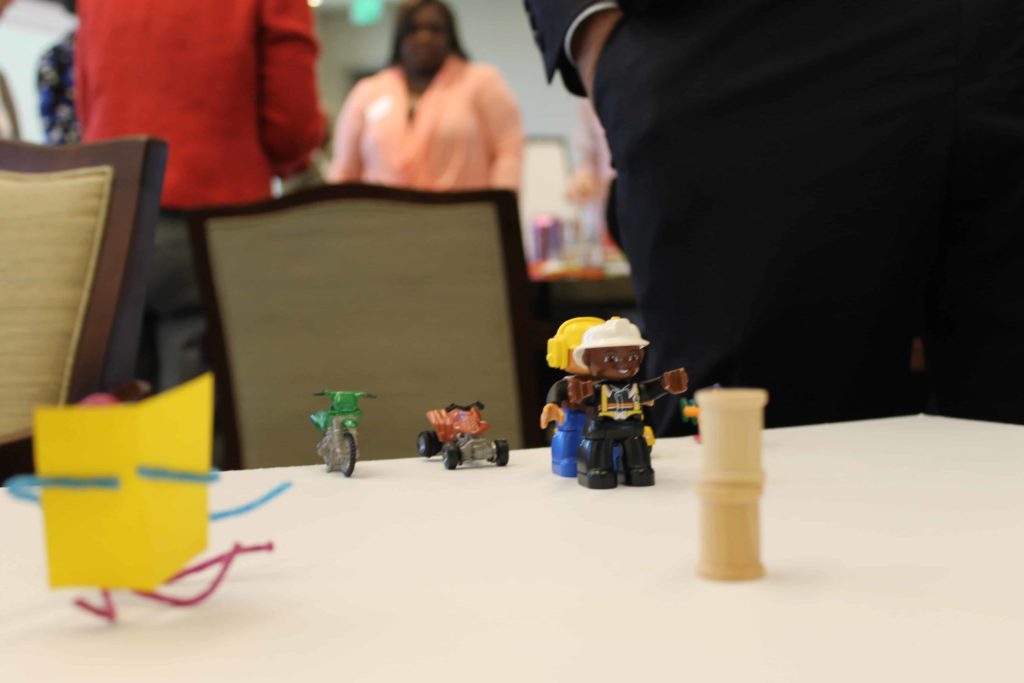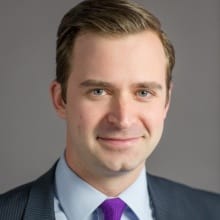

Along one wall of this rectangular conference room, clear storage boxes hold a random assortment of toys and art supplies—soldier figurines, Play-Doh, brightly-colored pipe cleaners. A middle-aged man paces near a projector screen at the front of the room and gives instructions to the class. “Some of you are like, ‘What am I supposed to build, dude?’” he tells the group. From their chairs, people giggle. “Start making.”
The mess looks more appropriate for a public school classroom than the limestone-clad Duke Endowment headquarters just outside uptown Charlotte. But a few dozen grown-ups file in, in their suits and dresses, ready to rummage through the bins. It is mid-January and coats are draped across chairs. Sunlight fills the room and people roll up their sleeves.
One man snags glittery construction paper, a rubber chicken, and an “Easy Button” that announces “That was easy!” every time someone smacks the top of it, which is often. Unlike children, the adults carefully sort through the containers and contemplate the potential uses for each item. The instructor is David Phillips, a consultant from Faster Glass, a firm that specializes in this kind of design workshop. He strolls over to the table. “Let’s not get caught up in the details,” Phillips says, hurrying people along. “Let’s just build it.”
The “it” these four dozen or so people are supposed to build in the next 10 minutes is not readily apparent. A few linger at the edge of the fray, skepticism wrinkling their faces. This “Rapid Prototyping Workshop” feels like something a tech company would do—to iterate on the new version of a smartphone, say—rather than an activity for an assortment of nonprofit and education leaders.
“This is the part of the process we often fail to do,” Phillips says, “because we’re serious grownups doing serious work, and serious grownups don’t play with Legos.”
A hum fills the room as four teams begin to build their models. This session, at the beginning of Read Charlotte’s 100 Day Challenge, is intended to spark creative thinking among these Action Learning Teams, each focused on a piece of the nonprofit’s plan to boost Mecklenburg County’s third grade reading rate.
The Belk Foundation’s Goals
Three years earlier, in 2014, the Belk Foundation called a meeting of Charlotte’s education, business, and philanthropic leaders to discuss a startling statistic: Only 39 percent of Mecklenburg County third grade students were reading at or above grade level. The rate outpaced the national average and the large city average, but it was nonetheless troubling. Third grade reading is a strong indicator of a student’s likelihood to graduate from high school and college.
The organizations committed $5 million to an aggressive goal: doubling the third grade reading rate by 2025. They created an organization, Read Charlotte, tasked with aligning the work various groups are already doing and coordinating a community-wide response to Charlotte’s literacy crisis.
Practically, the commitment means sessions like this one.


A scan of the room yields plenty of familiar faces, representatives from Charlotte-Mecklenburg Schools, the YMCA, and nonprofits, such as Freedom School Partners, that provide off-campus learning programs for children. They are broken into groups: family engagement, active reading, summer learning, and kindergarten success. The Lego-and-pipe-cleaner models they are building are supposed to jumpstart creative thinking. How, for example, do CMS and its partner organizations better educate parents on the best ways to read to their children when reaching families is already difficult?
“If you feel uncomfortable today,” Phillips says, “that’s OK and that’s not unexpected.” He says prototyping sessions like this one are similar to dating before marriage—there are lots of frogs to kiss before a prince appears.
The agenda calls for a 10-minute break, but no one wants to stop. Their work is too urgent and their mission too great to pause, even for a few minutes.
***
Next Steps
Munro Richardson slips into startup speak without thinking about it.
He is sitting in the basement of Charlotte’s uptown library branch, in a space that used to be reserved for kids before a newer facility was built down the street. The walls are still painted in bright colors, but the room has the kind of transitional vibe one would expect to find at the offices of an early stage company—it is affordable office space, but no one had time to spruce it up; charts are pinned to walls and papers cover desks.
“We’re interested in solving problems,” Richardson says. “We’re not interested in providing a program or a service. We think about metrics and customers. Sometimes we use business language and business examples.”
Richardson, Read Charlotte’s executive director, came to town from Kansas City, Missouri, in 2015. He has the enthusiasm of someone who was a Rhodes Scholar and holds a Ph.D., combined with the intensity of a business executive operating on borrowed time. “It’s very much like a venture model,” he tells me. “High accountability. Very public. We could fail in an epic way.”
Indeed, no community has been able to do what Read Charlotte wants to do. Success will not be found simply getting some of the smartest kids in town to do a little better on their tests; change won’t happen incrementally, but will require vast, systems-level shifts in classrooms and living rooms in all parts of the county.
To do that, Read Charlotte launched the 100 Day Challenge, a concentrated effort focused on what its staff calls a “transformation zone” in south-southwest Charlotte. The area was identified for its demographics, concentration of partner organizations, and test scores.
It is comprised of five public elementary schools in a diverse section of town that, on one side, contains neighborhoods of immigrants and some of the city’s working poor. A campus on the other end of the zone is less than two-and-a-half miles from Quail Hollow Club which will host the PGA Championship this summer. (The way CMS boundaries are drawn, few wealthy students are assigned to schools that fall within the transformation zone.)
Students in the transformation zone have varying degrees of reading proficiency. The most successful school, Smithfield Elementary, posted 64 percent end-of-grade reading proficiency on its latest North Carolina School Report Card; it promoted nearly 87 percent of its third graders to fourth grade under the state’s Read to Achieve legislation. The lowest performing school, Nations Ford Elementary, had just 31 percent end-of-grade reading proficiency and promoted 37 percent of its third grade students.
All of the schools except Smithfield are below the state average for the percent of kids who advanced from third to fourth grade. “It made it a really attractive place for us to plant a flag,” Richardson says. “We want to be sure we are engaging the community and not invading the community.”
Plus, given Mecklenburg County’s size and population, the organization’s staff could not handle coordinating work across the entire community while they figure out what works.
“We want to have some early wins to build that momentum,” says Maggie Wittman, a 20-something former Teach for America corps member who is now Read Charlotte’s program manager. As we talk, Wittman and Richardson explain that, because Read Charlotte does not run programs itself, the group’s work—and its success—will depend on others. “One of the first things we did early on was try to figure out the barriers to systems work,” she says. “One of the biggest ones was working in silos.”
The 100 Day Challenge is intended to tear down those silos, to get organizations working together and out of the same playbook. The group hopes that this intense period of work, and the efforts to come in the transition zone afterward, will illuminate strategies that can be applied in other sections of Mecklenburg County, the rest of the state, and the country. Other communities across North Carolina have taken note and are watching Read Charlotte for ideas that they can steal now.
“We’re very cognizant of making decisions that are scalable,” Richardson tells me. “It’s very easy for an organization to come in and do things in such a way that transforms and moves the trend lines, but you’re doing it in a way that’s just not scalable, whether that’s people, dollars, whatever.”
But, as Richardson readily admits, the endeavor could turn out to be an embarrassing defeat.
“When we think about failure,” he says, “it’s not about ourselves, it’s about failing kids.”
***
A New Beginning
The prototyping session is nearing an end, and the groups continue to play with their toys. Conversation among the teams is frenetic. Bits of dialogue rise above the din.
“This is really safe,” one person says.
“You have to make parents realize why they need to read to their kids.”
“I’d rather give them a choice instead of saying, ‘Hope you like our idea.’”
Their instructions were to fail quickly, to discard less effective ideas, and pivot as many times as necessary. “Fake it before you make it,” David Phillips, the facilitator, reminds them. All of the models need some degree of explanation; their purpose is not readily apparent.
Plastic figurines are tied together with pipe cleaners. A fake $5 bill is folded into thirds. The Easy Button is stuck to a white foam board. At first glance, it is difficult to understand how these models will do anything to advance reading among third graders.
After today’s session wraps up, the teams will present their dioramas to families at elementary schools within the transformation zone, explaining their concepts to increase family engagement or to better train people in active reading strategies. Because people process information differently, Phillips explains, models and words work together to keep everyone on the same page; nothing gets lost in translation.


Some of the professionals in this room are more comfortable with boardrooms and PowerPoints than with Legos and rubber chickens. They have weeks to meet deadlines and make presentations, not half an hour.
But if Read Charlotte is to succeed, its approach must be radical. “It if were easy and clear all the time, we’d do it,” Richardson tells the group.
“We know we’ve got a lot of work to do.”
Editor’s Note: This is the first of a series. Check back tomorrow for “Training the teachers.” The Belk Foundation supports the work of EdNC.


